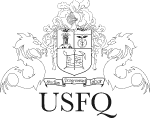http://repositorio.usfq.edu.ec/handle/23000/14837| Tipo de material: | bachelorThesis |
| Título : | Cuenca Arreica Cognitiva: infraestructura para el Plan Machay Ally Yaku 2125 |
| Autor : | Oyarte Muschett, Rafael André |
| Director de Tesis : | López Andrade, Jaime, dir. |
| Descriptores : | Arquitectura - Diseño y construcción - Tesis y disertaciones académicas |
| Fecha de publicación : | 9-may-2025 |
| Editorial : | Quito |
| Citación : | Tesis (Arquitecto), Universidad San Francisco de Quito, Colegio de Arquitectura y Diseño Interior; Quito, Ecuador, 2025 |
| Páginas : | 49 h. |
| Acceso: | openAccess Atribución-NoComercial-SinDerivadas 3.0 Ecuador |
| Resumen : | La degradación del río Machángara representa un desafío en la búsqueda de un equilibrio sostenible para Quito y su red hídrica. Este proyecto de fin de carrera propone una solución innovadora mediante el diseño de una cuenca arreica cognitiva en el parque Julio Andrade, implantada con estrategias del Plan Maestro Machay Ally Yaku. El enfoque principal es integrar soluciones basadas en la naturaleza (biomimética) con la teoría constructivista de Piaget, con el objetivo de crear una infraestructura que no solo acelere el proceso del ciclo hidrológico mediante la infiltración y recarga del acuífero centro-norte de Quito, sino que también funcione como un medio para fortalecer la comprensión comunitaria del ciclo hidrológico al que pertenece... |
| Descripción : | The degradation of the Machángara River represents a challenge in the search for a sustainable balance for Quito and its water network. This final degree project proposes an innovative solution through the design of a cognitive endorheic basin in the Julio Andrade Park, implemented with strategies from the Machay Ally Yaku Master Plan. The main focus is to integrate nature-based solutions (biomimicry) with Piaget's constructivist theory, with the objective of creating an infrastructure that not only accelerates the hydrological cycle process through infiltration and recharge of the north-central aquifer of Quito, but also functions as a means to strengthen community understanding of the hydrological cycle to which it belongs. In the Ecuadorian context, the project responds to the constitutional mandate that demands the recovery of the Machángara River and addresses critical problems facing the city, such as floods and biodiversity loss... |
| URI : | http://repositorio.usfq.edu.ec/handle/23000/14837 |
| Aparece en las colecciones: | Tesis - Arquitectura |
| Fichero | Descripción | Tamaño | Formato | |
|---|---|---|---|---|
| 216770.pdf | Texto completo | 5.68 MB | Adobe PDF |  Visualizar/Abrir |
Este ítem está sujeto a una licencia Creative Commons Licencia Creative Commons


